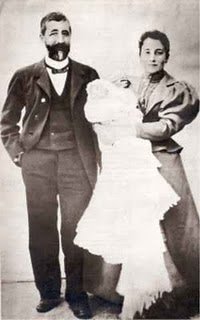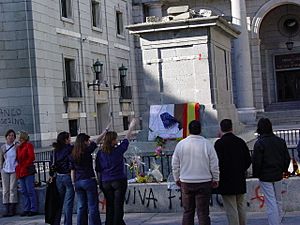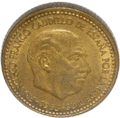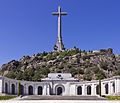Francisco Franco facts for kids
Quick facts for kids
His Excellency the Head of State
Generalísimo Francisco Franco
|
|
|---|---|
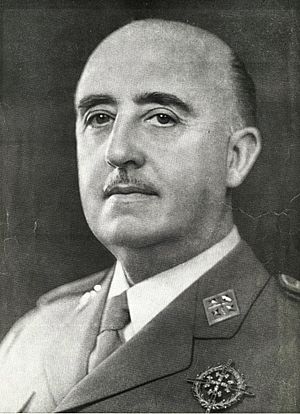 |
|
| Head of State of Spain | |
| In office 1 October 1936 – 20 November 1975 |
|
| Prime Minister | Himself Luis Carrero Blanco Carlos Arias Navarro |
| Preceded by | Manuel Azaña (President of Spain) |
| Succeeded by | Juan Carlos I (King of Spain) |
| Prime Minister of Spain | |
| In office 30 January 1938 – 9 June 1973 |
|
| Head of State | Himself |
| Deputy | |
| Preceded by | José Miaja |
| Succeeded by | Luis Carrero Blanco |
| Personal details | |
| Born | 4 December 1892 Ferrol, Galicia, Kingdom of Spain |
| Died | 20 November 1975 (aged 82) Madrid, Spanish State |
| Resting place |
|
| Political party | FET y de las JONS |
| Spouse |
Carmen Polo
(m. 1923) |
| Children | María del Carmen |
| Relatives | Nicolás Franco (brother) Ramón Franco (brother) Francisco Franco (cousin) Ricardo de la Puente (cousin) |
| Residences | El Pardo, Madrid |
| Education | Infantry Academy of Toledo |
| Signature | |
| Nickname | Caudillo |
| Military service | |
| Allegiance | Kingdom of Spain (1907–1931) Spanish Republic (1931–1936) Spanish State (1936–1975) |
| Branch/service | Spanish Armed Forces |
| Years of service | 1907–1975 |
| Rank | Captain general of the Army Captain general of the Air Force Captain general of the Navy |
| Commands | All (Generalísimo) |
| Battles/wars | 2nd Melillan Campaign (WIA) Rif War Revolution of 1934 Spanish Civil War Ifni War |
Francisco Franco Bahamonde (born December 4, 1892 – died November 20, 1975) was a Spanish military general. He led the Nationalist forces to victory in the Spanish Civil War. After the war, he ruled Spain as a dictator from 1939 until his death in 1975. During this time, he was known as Caudillo, which means "leader." This period in Spanish history is often called Francoist Spain.
Franco was born in Ferrol, Galicia, into a military family. He joined the Spanish Army and quickly rose through the ranks. By age 33, he became the youngest general in Europe. He was a conservative and supported the monarchy. He was unhappy when the Second Republic was created in 1931. In 1936, he joined a military coup that led to the Spanish Civil War.
During the war, Franco became the main leader of the Nationalist side. He brought all the nationalist parties together to form one political party, the FET y de las JONS. After three years, the Nationalists won the war. Franco's rule was marked by strict control and punishment of those who opposed him.
Spain remained neutral during World War II, but Franco supported the Axis powers (Germany and Italy) who had helped him in the Civil War. After World War II, Spain faced economic problems. However, Franco's government later introduced new economic policies that led to a period of fast growth called the "Spanish miracle". Spain also gained support from the United States during the Cold War because Franco was against communism. Franco died in 1975, and Spain then began its move towards democracy.
Contents
Franco's Early Life
Francisco Franco Bahamonde was born on December 4, 1892, in El Ferrol, a town in Galicia, Spain. His family had a long history of serving in the Spanish Navy. His father, Nicolás Franco Salgado-Araújo, was also a naval officer.
His mother, María del Pilar Bahamonde y Pardo de Andrade, came from a middle-class Catholic family. Franco had two brothers, Nicolás and Ramón, and two sisters, María del Pilar and María de la Paz. His brother Ramón became a famous aviator.
When Franco was 14, his father moved away from the family. Franco did not get along well with his father. However, he was very close to his mother and learned important values from her, like self-control and respect for Catholicism.
Franco's Military Career
Joining the Army and Fighting in Morocco
Franco wanted to join the Navy like his father. But after the Spanish–American War, Spain's navy was much smaller. So, Franco decided to join the Spanish Army instead. In 1907, at age 14, he entered the Infantry Academy in Toledo. He was one of the youngest students there.
After graduating, Franco was sent to Morocco. Spain was trying to control this area, which led to fighting with local Moroccan groups. This was known as the Second Melillan campaign and later the Rif War. Officers could get promoted quickly by showing bravery in battle. Franco soon became known as a very effective officer.
In 1913, Franco joined the regulares, which were Moroccan troops led by Spanish officers. These were elite fighting units. In 1916, when he was 23 and a captain, Franco was shot in the stomach during a battle. He was seriously wounded but survived. His Moroccan soldiers believed he was blessed because he recovered. He was promoted to major in 1917, making him the youngest major in the Spanish army at 24.
Leading the Spanish Legion
In 1920, Franco became the second-in-command of the new Spanish Foreign Legion. This group was similar to the French Foreign Legion. In 1923, he became the commander of the Legion. He led the first troops ashore at Al Hoceima in 1925, which helped end the Republic of the Rif. For his leadership, he was promoted to brigadier general in 1926. At 33, he was the youngest general in Europe.
In 1928, Franco became the director of the new General Military Academy of Zaragoza. This school trained all future Spanish army officers.
During the Second Spanish Republic
In 1931, the monarchy ended, and the Second Republic was formed. Franco was sad to see the monarchy go, but he continued to serve in the army. However, the new government closed his military academy, which upset him.
Spain's new constitution brought many changes, including reducing the power of the Catholic Church. Franco, a strong Catholic, believed there was a plot by Jews, Freemasons, and Communists to harm Christian Europe.
In 1934, a major workers' strike happened in Asturias. Miners and other workers took up arms. Franco was put in charge of stopping this uprising. He used troops from the Spanish Army of Africa to put down the rebellion. This made him known as an officer willing to use force against Spanish civilians.
In February 1936, Franco was sent to the Canary Islands as military commander. This was seen as a way to keep him away from Madrid. Meanwhile, other generals were planning a military coup. Franco joined them, and on July 18, 1936, the army rebelled. This started the Spanish Civil War.
From Civil War to World War II
The Spanish Civil War Begins
The Spanish Civil War lasted from July 1936 to April 1939. Franco became the leader of the Nationalist forces. He quickly took control of the Spanish Moroccan Protectorate. He also had to move his troops to mainland Spain. Most of the navy stayed loyal to the Republic, blocking the Strait of Gibraltar.
Franco asked for help from Benito Mussolini of Italy and Adolf Hitler of Germany. They sent planes and weapons. With this help, Franco was able to fly his troops across the strait and begin his advance into Spain.
Both sides received foreign help. Franco's Nationalists were supported by Fascist Italy and Nazi Germany. The Republican side was supported by the Soviet Union and volunteers from other countries who formed the International Brigades.
Franco Becomes Leader
The original leader of the uprising, General José Sanjurjo, died in a plane crash shortly after the war began. This left a power vacuum among the Nationalists. On September 21, 1936, Franco was chosen as the commander-in-chief of the Nationalist army. On October 1, 1936, he was officially named Generalísimo (supreme general) and Jefe del Estado (Head of State).
Franco was good at organizing, planning, and diplomacy. He personally led military operations. He also brought together different right-wing groups into one party, the FET y de las JONS. This became the only legal party under his rule. Franco presented himself as the defender of "Catholic Spain" against "atheist communism."
The End of the Civil War
By early 1939, most of Spain was under Nationalist control. On March 28, 1939, Madrid fell to Franco's forces. The war officially ended on April 1, 1939, when the last Republican forces surrendered.
After the war, Franco's government carried out harsh actions against political opponents. This period is known as the White Terror. Many people were executed or imprisoned.
Some Spanish fighters who were against Franco continued to resist him from France. They were called the Maquis. Their actions continued into the 1950s. Many Republicans also went into exile in other countries like France, Mexico, and Chile.
Spain During World War II
When World War II started in September 1939, Franco decided Spain would remain neutral. However, he had received help from Hitler and Mussolini during the Civil War, and he made speeches that seemed to support the Axis powers.
On October 23, 1940, Hitler and Franco met in Hendaye, France. Hitler wanted Spain to join the Axis, but Franco had many demands, including large amounts of food and fuel, and control over Gibraltar and parts of French North Africa. Hitler found Franco's demands too high. Some historians believe Franco made these demands on purpose to avoid joining the war. Others think Spain was simply too weak after its Civil War to fight another major war.
Franco allowed Spanish volunteers to fight with the German army against the Soviet Union. This unit was called the Blue Division. However, he did not allow Spaniards to fight against the Western democracies.
Spain's neutrality was important to the Allies. In 1944, Winston Churchill said that Spain's decision not to let Germany pass through its territory was very helpful to the Allies. After the war, Spain tried to hide evidence of its cooperation with the Axis.
Treatment of Jewish People
Franco's government had a complicated relationship with Jewish people during World War II. Franco made some anti-Jewish comments. Documents show that in 1941, he ordered a list of Jewish people in Spain to be made while he was talking about an alliance with the Axis powers. He even gave a list of 6,000 Jewish people in Spain to Heinrich Himmler, a high-ranking Nazi official.
However, Spain also helped many Jewish people escape the Nazis. Spanish diplomats provided visas for thousands of French Jews to travel through Spain to Portugal. They also protected about 4,000 Jewish people in countries like Hungary and Romania. It is estimated that between 20,000 and 30,000 Jewish people passed through Spain during the first half of the war. After the war, Franco exaggerated his role in saving Jewish people to improve Spain's image.
Franco's government strongly supported the Catholic Church. It did not support religious freedom for non-Catholics at first. However, as Spain's foreign policy shifted towards the United States during the Cold War, the situation changed. By 1967, a new law granted more public religious rights to non-Catholics.
Spain Under Franco's Rule
Franco was the undisputed leader of Spain. He had more power than any Spanish leader before him. For the first few years after the Civil War, he ruled mostly by decree, meaning he made laws without much input from others.
In 1942, Franco created a parliament called the Cortes Españolas. However, it had little real power. Franco appointed and dismissed ministers himself.
In 1947, Franco declared Spain a monarchy, but he did not name a king. Instead, he made himself a regent for life, meaning he ruled in place of a king. He used many symbols of a king, like wearing a special uniform and having his portrait on coins.
Franco's government used strict control over society. Non-government trade unions and all political parties that opposed him were banned or tightly controlled. The Guardia Civil, a military police force, patrolled towns and rural areas to maintain order.
Franco promoted a single Spanish identity. He encouraged traditions like bullfighting and flamenco. He also promoted the use of Castilian Spanish and tried to suppress other languages like Catalan, Galician, and Basque in official settings. However, people continued to speak these languages in their daily lives.
The Catholic Church was the official state religion. Civil servants had to be Catholic, and divorce was forbidden.
Economic Changes in Spain
The Civil War badly damaged Spain's economy. For more than ten years after the war, the economy struggled. Franco first tried a policy of "autarky," meaning Spain would try to be self-sufficient and cut off most international trade. This policy had very bad effects.
Facing economic collapse, Spain was pressured by the United States and the IMF to adopt a more open, free-market economy. Franco replaced some of his old ministers with experts in economics. This led to major economic reforms.
From 1959 to 1974, Spain experienced a period of rapid economic growth known as the "Spanish miracle". International companies built factories in Spain, and state-owned companies expanded. Spain became the second-fastest growing economy in the world during this time, just behind Japan. By the time Franco died in 1975, Spain had a large industrial economy, though it still lagged behind many Western European countries.
Many Spaniards also moved to other European countries for work during this time. This helped the Spanish economy because these workers sent money back home.
Succession and Death
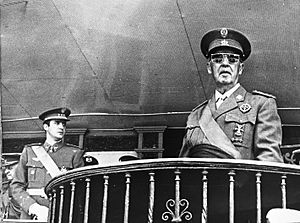
In the late 1960s, Franco decided to name a monarch to take over after him. In 1969, he officially chose Prince Juan Carlos de Borbón as his successor. Juan Carlos had been educated by Franco in Spain.
By 1973, Franco gave up his role as prime minister, but he remained head of state and commander-in-chief of the military.
Franco's health declined in his final years. He suffered from Parkinson's disease. His last public appearance was on October 1, 1975. He died on November 20, 1975, at the age of 82.
Two days later, on November 22, Juan Carlos was proclaimed King of Spain. Franco's body was buried at the Valley of the Fallen (Valle de los Caídos). This was a huge memorial built by political prisoners to honor those who died in the Civil War. Franco was the only person buried there who did not die during the war.
Franco's Legacy
Franco's legacy in Spain is still a topic of much discussion. For nearly 40 years, many Spaniards were taught that Franco saved Spain from chaos. Historians like Stanley Payne have called him one of the most important figures in Spanish history.
His supporters say he kept Spain neutral in World War II and helped its economy grow. They also highlight his strong anti-communist views. People like Winston Churchill and Charles de Gaulle respected his stance during the Cold War.
However, critics strongly condemn him as a harsh ruler. They point to the thousands of deaths and the political repression that happened under his rule. They also note his support for the Axis powers during World War II.
After Franco's death, Spain moved towards democracy. The main political parties agreed to a "Pact of Forgetting," meaning they would not investigate or prosecute crimes from the Civil War or Franco's rule. This agreement was meant to help Spain move forward peacefully. However, this changed after 2000, and there is now a public debate about remembering the past.
Many Spaniards who suffered under Franco's rule have worked to remove memorials of his regime. Most streets and buildings named after him have been renamed. In 2007, the Spanish government banned official public references to the Franco regime and began removing statues and memorials.
In 2019, Franco's body was moved from the Valley of the Fallen to a private cemetery. This decision was made by the Spanish government to show respect for the victims of the Civil War. The move was supported by many, but also opposed by some of Franco's supporters.
Franco's rule also influenced other dictators, especially in South America. For example, Augusto Pinochet of Chile admired Franco.
In Popular Media
Cinema and Television
- Raza (1941) was a film based on a script written by Franco himself. It tells the story of a military officer.
- Dragon Rapide (1986) shows the events leading up to the Spanish Civil War.
- In the Spanish TV series El Ministerio del Tiempo (2015), Franco is played by actor Pep Mirás in an episode about his meeting with Adolf Hitler.
Music
- The French singer Léo Ferré wrote a song called "Franco la muerte" (Franco the Death) in 1964, strongly criticizing the dictator.
Literature
- Franco is a character in CJ Sansom's book Winter in Madrid.
- ...Y al tercer año resucitó (...And On the Third Year He Rose Again) (1980) is a novel that imagines what would happen if Franco came back from the dead.
Images for kids
-
Francisco and his brother Ramón in North Africa, 1925
-
Heinrich Himmler and Franco in Madrid, October 1940
-
Franco and Adolf Hitler in Meeting at Hendaye, 1940
-
Franco in Reus, 1940
-
Lluís Companys, president of Catalonia under the Republic, who was executed by Franco in 1940
-
1963 Spanish peseta coin with an image of Franco
-
Carlos Arias Navarro and Franco at his residence in October 1975
-
In 2019 Franco's body was removed from the monument of Santa Cruz del Valle de los Caídos.
-
Sign in Santa Cruz de Tenerife for a street bearing Franco's name which was renamed in 2008
Error: no page names specified (help). In Spanish: Francisco Franco para niños
In Spanish: Francisco Franco para niños
- Military career and honours of Francisco Franco
- Language politics in Francoist Spain
- List of dictators in modern times
- Symbols of Francoism
- "Generalissimo Francisco Franco is still dead."


